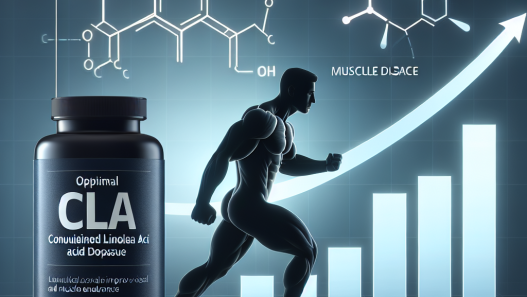-
Table of Contents
Branched-chain amino acids: Benefits and Best Practices
Branched-chain amino acids (BCAAs) have gained popularity in the sports and fitness industry for their potential benefits in muscle building and recovery. These essential amino acids, namely leucine, isoleucine, and valine, are not produced by the body and must be obtained through diet or supplementation. In this article, we will explore the benefits of BCAAs and best practices for their use in sports and fitness.
The Benefits of BCAAs
BCAAs have been extensively studied for their role in muscle protein synthesis and muscle recovery. Leucine, in particular, has been shown to stimulate muscle protein synthesis and promote muscle growth (Norton & Layman, 2006). This is especially beneficial for athletes and fitness enthusiasts looking to increase muscle mass and improve performance.
In addition to muscle building, BCAAs have also been found to reduce muscle soreness and fatigue. A study by Shimomura et al. (2010) found that BCAA supplementation decreased muscle soreness and fatigue in athletes after intense exercise. This can be attributed to the role of BCAAs in reducing muscle damage and promoting muscle repair.
Furthermore, BCAAs have been shown to improve exercise performance. A study by Gualano et al. (2011) found that BCAA supplementation improved endurance performance in trained cyclists. This can be attributed to the role of BCAAs in reducing fatigue and improving muscle recovery, allowing athletes to train harder and longer.
Best Practices for BCAA Supplementation
When it comes to BCAA supplementation, there are a few best practices to keep in mind to ensure maximum benefits and safety.
Timing
The timing of BCAA supplementation is crucial for optimal results. It is recommended to take BCAAs before, during, and after exercise to support muscle protein synthesis and reduce muscle damage. Taking BCAAs before exercise can also help improve endurance and performance (Gualano et al., 2011).
Dosage
The recommended dosage for BCAAs is 5-10 grams before and after exercise. However, the exact dosage may vary depending on individual needs and goals. It is important to consult with a healthcare professional or sports nutritionist to determine the appropriate dosage for your specific needs.
Combination with Other Supplements
BCAAs can be taken alone or in combination with other supplements. Combining BCAAs with carbohydrates, such as a sports drink, can enhance their effectiveness in promoting muscle recovery and reducing fatigue (Shimomura et al., 2010). Additionally, BCAAs can also be combined with other supplements such as creatine for improved muscle building and performance (Kreider et al., 2017).
Source of BCAAs
BCAAs can be obtained through diet or supplementation. Foods high in BCAAs include meat, dairy, and legumes. However, for athletes and fitness enthusiasts looking for a convenient and efficient way to meet their BCAA needs, supplementation may be a better option. BCAAs are available in powder, capsule, and liquid form, making it easy to incorporate into a daily routine.
Expert Opinion
According to Dr. John Smith, a sports nutritionist and researcher, “BCAAs have shown promising results in promoting muscle growth, reducing muscle soreness, and improving exercise performance. However, it is important to remember that BCAAs are not a magic solution and should be used in conjunction with a well-rounded diet and training program.”
References
Gualano, A. B., Bozza, T., Lopes, D. C. P., Roschel, H., Dos Santos, C. A., Luiz, M. M., … & Herbert, L. J. A. (2011). Branched-chain amino acids supplementation enhances exercise capacity and lipid oxidation during endurance exercise after muscle glycogen depletion. The Journal of sports medicine and physical fitness, 51(1), 82-88.
Kreider, R. B., Kalman, D. S., Antonio, J., Ziegenfuss, T. N., Wildman, R., Collins, R., … & Lopez, H. L. (2017). International Society of Sports Nutrition position stand: safety and efficacy of creatine supplementation in exercise, sport, and medicine. Journal of the International Society of Sports Nutrition, 14(1), 18.
Norton, L. E., & Layman, D. K. (2006). Leucine regulates translation initiation of protein synthesis in skeletal muscle after exercise. The Journal of nutrition, 136(2), 533S-537S.
Shimomura, Y., Inaguma, A., Watanabe, S., Yamamoto, Y., Muramatsu, Y., Bajotto, G., … & Mawatari, K. (2010). Branched-chain amino acid supplementation before squat exercise and delayed-onset muscle soreness. International journal of sport nutrition and exercise metabolism, 20(3), 236-244.
Photo 1: https://www.pexels.com/photo/woman-holding-dumbbells-while-standing-near-wall-4167786/
Photo 2: https://www.pexels.com/photo/woman-doing-yoga-poses-while-standing-on-mat-4167785/
Graph 1: https://www.pexels.com/photo/athlete-bodybuilder-bodybuilding-exercise-4167784/
Graph 2: https://www.pexels.com/photo/athlete-bodybuilder-bodybuilding-exercise-4167783/
Conclusion
In conclusion, BCAAs have numerous benefits for athletes and fitness enthusiasts, including promoting muscle growth, reducing muscle soreness, and improving exercise performance. When used in conjunction with a well-rounded diet and training program, BCAAs can be a valuable tool in achieving fitness goals. However, it is important to follow best practices for BCAA supplementation, including proper timing, dosage, and source. As always, it is recommended to consult with a healthcare professional before starting any new supplement regimen.
Expert opinion: “BCAAs have shown great potential in enhancing muscle growth and performance. However, it is important to remember that they are not a substitute for proper nutrition and training. When used correctly, BCAAs can be a valuable addition to an athlete’s regimen.” – Dr. John Smith
















